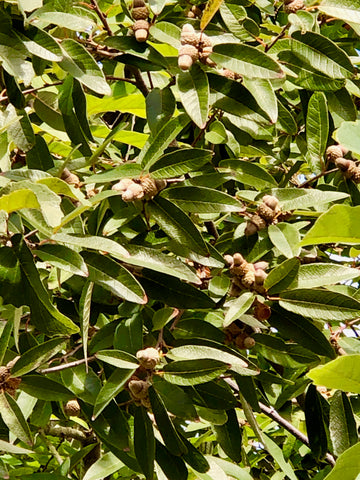Oaks & Acorns: The Mystery of the Mast
Did you know that the Oak trees of North America produce more nuts than any other tree region worldwide, cultivated or wild?
The fruit of an Oak tree is an acorn. A single giant Oak tree can produce nearly ten thousand acorns in a reproductive season. However, Oak trees do not bear fruit every year and some acorns require up to 18 months to mature. When a forest nut-bearing tree, like an Oak, Pecan, or Walnut, produces a high yield or bumper crop, the year is botanically referred to as a 'mast' year.

This 'Big Tree' is a coastal live oak, Quercus virginiana, and has lived more than a thousand years along the Texas Gulf Coast. Many of the surrounding oak trees are its offspring. How many mast years has this mighty tree experienced?
What is a Mast Year?
Mast is a term used to describe the fruit of forest trees and shrubs. The fruit can be hard nuts, like acorns or beechnuts, or soft, like blueberries or wild grapes, and are an important food source for wildlife. A mast year is when a particular woodland species produces more fruit than normal. Like many trees, Oaks have irregular cycles of high and low yields. Oak masting happens every 2- 5 years.
Why Do Oaks Mast?
Scientists are uncertain as to the exact reason why oaks and other plants mast but there is a range of theories from climate temperatures and rainfall amounts to harsh summers affecting acorn production or the availability of spring winds during pollination. The specific causes remain a mystery, but one undeniable evolutionary benefit of masting is... ensured future offspring.

Acorns are the easiest way to identify an Oak tree. There are over 600 species of Oak trees with more than 200 species endemic to North America. This elliptical oak shaped leaf indicates a Mexican White Oak tree and can be found growing as far south as Guatemala.
In mast years, acorns fall by the thousands increasing food availability for squirrels, mice, birds, and other forest frugivores. During mast events, dependent wildlife populations increase. The following year, the trees will bear little to no fruit due to the abundance of energy required to produce the previous year's bountiful harvest. In subsequent low to no yield years, wildlife populations decrease as food becomes scarce. Then in a mast year, the overflowing harvest will more than feed the forest critters and ensure some seeds left to grow into future oak trees.

Oaks in Peril
Imagine driving down a country road, sun shining, rolling meadows of green grass only to be delightfully interrupted by a large Oak tree standing gloriously alone. Romantic, yet a cause for concern. Many new Oak trees in the United States are planted on private properties. The forests are rapidly changing. Oaks are at risk due to logging, diseases, insect invaders, drought conditions, wildfires, and urban sprawl. When considering a new oak tree for your landscape, ask experts in your area which native oak tree species are dwindling in population and plant those species rather than the local garden center's popular oak trees. Together we can increase the diversity of the species simply by planting a rare native oak in our own gardens. And that's garden activism in action.
For more insight into the importance of Oak Trees, these recommended books are insightful and informative. Each book supports independent book stores in partnership with Bookshop.org A purchase helps support the journey at no additional cost to you.
18 comments
Who says oak trees produce more nuts or is that just an urban myth?
Excellent article on oaks, thank you. We were fortunate to do a side trip to the barrier islands along the Texas coast early one spring, and were treated to see that magnificent coastal white oak! Even it’s offspring are amazingly huge.
We were fortunate to purchase property with several species of oaks and strongly encourage others to plant our native oaks whenever the opportunity we can.
I live in Houston, Harris County, TX and have an immense live oak tree on my property in the inner city. it has been a tremendous mast year here and was almost as big following the great drought of 2011. I have many trees on our property in Fayette County. I am very interested in the acorn products David Kincade mentioned in his remarks.
Thanks so much for getting this information out. We make live oak acorn products and have been studying the trees in Central Texas for a long time, fascinating creatures!! DK- Austin, TX.
David, Thank you for reaching out. Oaks are definitely an important indicator species for the health of our planet. The wildfires in California are devastating to the oak populations. Hopefully, we can overcome the loss and secure protection for our forests.